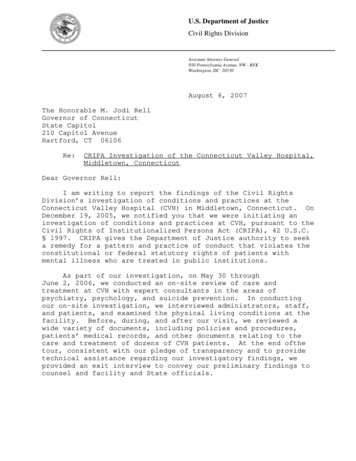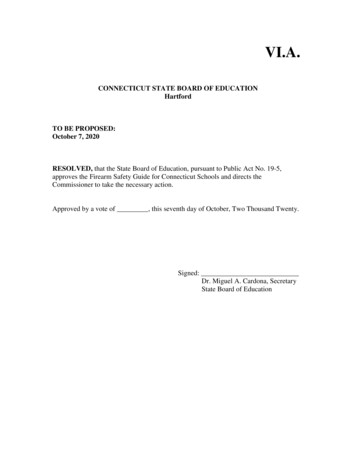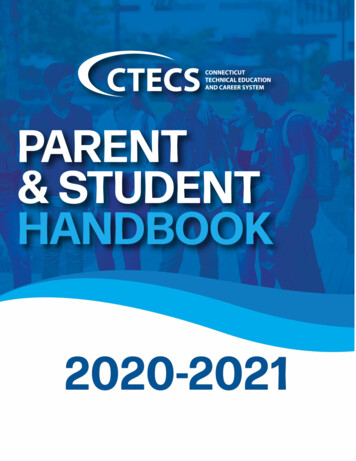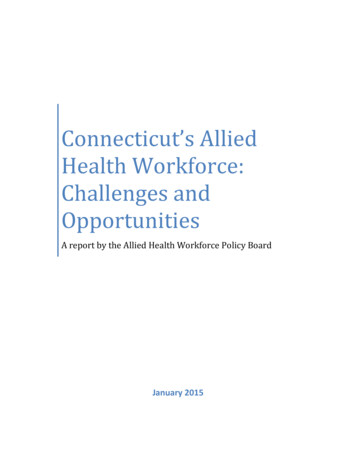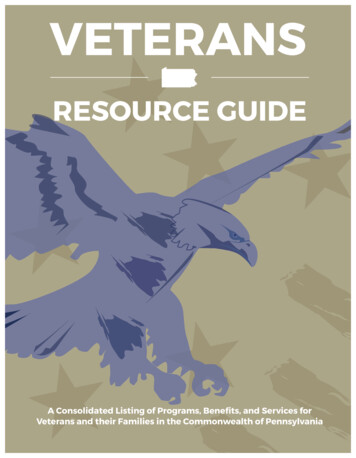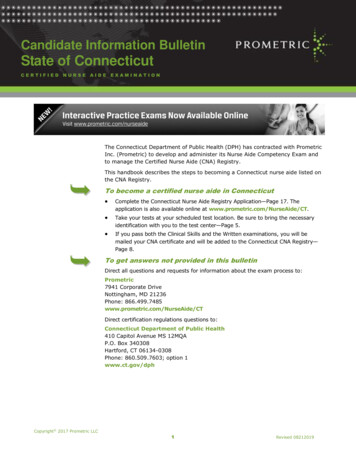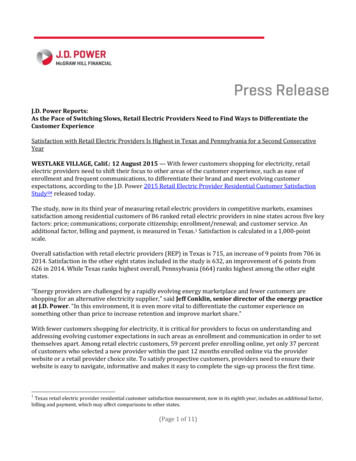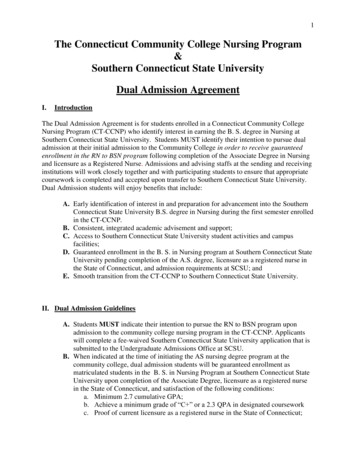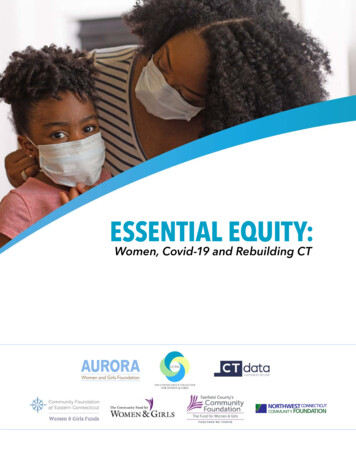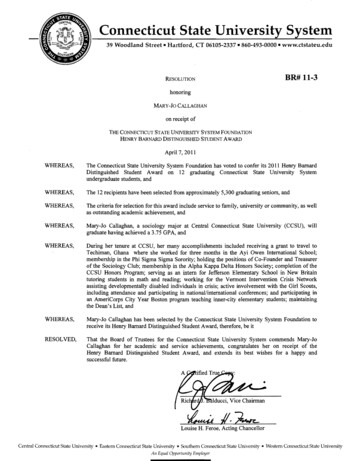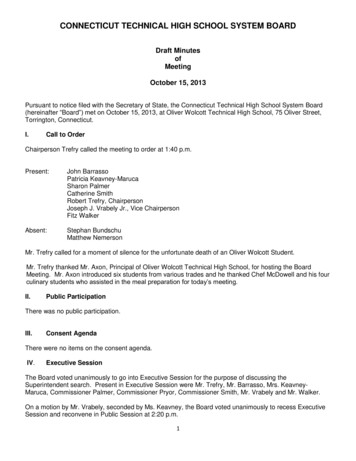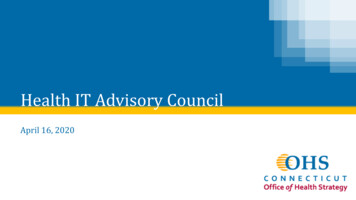
Transcription
Health IT Advisory CouncilApril 16, 2020
AgendaAgenda ItemTimeWelcome & Call to Order1:00 PMPublic Comment1:05 PMReview and Approval of Minutes – March 19, 20201:10 pmAnnouncements & General Discussion1:15 PMUpdate on Prescription Drug Monitoring Program1:25 PMReview Consent Design Guiding Principles Public Input2:05 PMReview and Approve HIT Advisory Council Charter2:45 PMWrap up and Meeting Adjournment3:00 pm2
Welcome and Call to Order3
Public Comment(2 minutes per commenter)4
Review and Approval of:March 19, 2020 Meeting Minutes5
Announcements and General DiscussionAllan Hackney, Council Members6
Update on Prescription Drug MonitoringProgramRod Marriott, DCP7
PRESCRIPTION MONITORING PROGRAMTHE CONNECTICUT PRESCRIPTION MONITORINGANDREPORTING SYSTEM (CPMRS)
Prescription Monitoring Program Program Overview– Background– CPMRS Data Snapshot CPMRS – PMP AWARxE Platform– User Interface - NarxCare– Clinical Alerts– Prescriber Report– Interstate data sharing– Mobile App PMP Clearinghouse - Data Submission– PDMP Standard Submission Format
OverviewProgram HistoryProgram DataFunctionalityUploading
Prescription Monitoring Program In 2006, legislators enacted Section 21a-254 providing for a PMP. The CT PMP became fully operational in February 2008. Data collection began in July of 2008 Access to minimum of three years of data Funding through the U.S. Department of Justice (DOJ) and the U.S.Department of Health & Human Services (HHS)
Prescription Monitoring ProgramContinuedPublic Act 13-172 (Effective 6/21/2013) All prescribers in possession of a Controlled Substance Practitioner(CSP) registration, will be required to register as a user with theConnecticut Prescription Monitoring and Reporting System (CPMRS) athttps://connecticut.pmpaware.net. Any prescribers who dispense controlled substances from theirpractice, or facility, etc., will be required to upload dispensinginformation into the CPMRS Data Collection website athttps://pmpclearinghouse.net.
Prescription Monitoring ProgramContinuedPublic Act 15-198 & June Special Session Public Act 15-5, Sec. 354(Effective 10/1/2015) Prior to prescribing greater than a 72-hour supply of any controlledsubstance (Schedule II - V) to any patient, the prescribing practitioneror such practitioner's authorized agent who is also a licensed healthcare professional shall review the patient's records in the ConnecticutPrescription Monitoring and Reporting System (CPMRS) athttps://connecticut.pmpaware.net. Whenever a prescribing practitioner prescribes controlled substancesfor the continuous or prolonged treatment of any patient, suchprescriber, or such prescriber's authorized agent who is also a licensedhealth care professional, shall review, not less than once every ninetydays, the patient's records in the CPMRS.
Prescription Monitoring ProgramContinuedPublic Act 15-198 & June Special Session Public Act 15-5, Sec. 354(Effective 10/1/2015) Effective 7/1/2016, daily submittal (immediately upon, but in no event laterthan the next business day) Veterinarians are not subjected to the mandated daily reporting that wentinto effect 7/1/2016. For veterinary dispensaries, dispensation reports arestill due weekly on Mondays with a six-day grace period.
Prescription Monitoring ProgramContinuedPublic Act 16-43, Sec.9 (Effective 7/1/2016) Effective 7/1/2016, daily submittal (immediately upon, but in no event laterthan the next business day) Practitioner's authorized agent, licensed or unlicensed, may register fortheir own CPMRS user account. Whenever a prescribing practitioner prescribes greater than a 72-hoursupply of any Schedule V controlled substance for the treatment of anypatient, such prescriber, or such prescriber's authorized agent, shall review,not less than annually, the patient's records in the CPMRS.
Prescription Monitoring ProgramContinuedPublic Act 17-131, Sec.1 (Effective 6/30/2017) Requires electronic prescribing of controlled substances (see ElectronicPrescribing of Controlled Substances for more information)
What Kind of Drugs are Reported?SCHEDULE II –Oxycontin, marijuana, Vicodin, methadone, morphine, RitalinSCHEDULE III –Suboxone, testosterone, Tylenol with CodeineSCHEDULE IV –Valium (diazepam), Xanax (alprazolam), AmbienSCHEDULE V –Lyrica, Epidiolex, Lomotil, Robitussin AC, CBD
Who Must Report? Pharmacies (resident and non-resident) Medical Marijuana Dispensaries Dispensing Prescribers (e.g. veterinarians)
Who May Access Information? Prescribers for their patients only– Authorized delegates (unlicensed/licensed) Pharmacists for their patients only– Authorized delegates (Pharmacy Technicians) Law Enforcement– Only for individuals tasked with drug investigations– Must have an active case number in order to request anyinformation from the system
CPMRS Data: Snapshot
DisclaimerAll of the data reported by the PMP is compiled at specific points intime and captures only data currently entered at that time. The datavalues may subsequently be updated and may change as over timeas those updates occur. Accordingly, quarterly reported data maynot perfectly match annually reported data. The data does notcontain any information about the diagnosis and does not reflectthe use intended by the prescriber.
Dispensation Data
Controlled Substance Rx/Year7,800,0007,200,0006,600,000Number of 0600,00002015*2019 prescription data as of February 20202019
2019 Prescriptions per Quarter2,000,0001,800,0001,600,000Number of 51,2361,809,6601,848,9011,915,388Quarter 1Quarter 2Quarter 3Quarter 4600,000400,000200,0000*2019 prescription data as of February 2020
2019 Payment Type of PrescriptionsUnspecified1%Workers Comp0%Insurance38%Private Pay35%Military1%Medicare11%*2019 prescription data as of February 2020Medicaid14%
CPMRS Utilization Data
Users Registered in the CPMRS per Year28,79130,00026,93426,015Number of 15702,9434302017Pharmacist1In2018Pharmacist's DelegatePrescriber2019Prescriber Delegate2019, legislation was passed allowing pharmacists to have a delegate searchpatients on their behalf.1,524
CPMRS User Searches per Year1,392,3911,400,0001,237,9331,130,511Number of harmacistPrescriber2019Law Enforcement
CT Controlled Substance Registrations vs. CTPractitioners Writing at least 1 CS ,00019,0125,0000CT Controlled Substance RegistrationsCT Practitioners Writing at least 1 CS Prescription
% of Prescribers Utilizing CPMRS whowrote at least 1 CS 182019
Unsolicited Reporting: Clinical Alerts
Clinical AlertsClinical alerts are indicators of patients that may be at a high risk for an overdose.Practitioners are asked to review the patient's CPMRS report and use it as a tool todetermine the appropriate level of care. Unsolicited report.- Prescriber & Dispenser ThresholdGenerated when a specified number of Prescribers and or Dispensers is met orexceeded within a set time period.Current threshold: 5 Prescriber AND 5 Pharmacies WITHIN the last 3 months.- Daily Active MME ThresholdGenerated when the daily active MME (morphine milligram equivalent) is greater thanor equal to specified values.Current threshold: 90 MME/day- Opioid & Benzodiazepine ThresholdGenerated when Opioids and Benzodiazepines are prescribed concurrently.
Unsolicited Reporting: Prescriber Report
Prescriber ReportsThe Prescriber Report is intended to give prescribers insight intotheir opioid prescribing patterns.Issued quarterly to all registered CPMRS users with an activeaccount AND a defined role AND specialty who have written at leastONE opioid prescription during the prior six-month period.Disclaimer: Comparisons with peer groups are meant to give prescribers a point ofreference. The PMP recognizes that no two practice settings are identical. Additionally,this report is not intended to be an indication that the prescriber or his/her patientshave done something wrong. If you believe one or more of your patients may havesubstance use disorder (SUD), we encourage you to review the PMP educationalmaterials, www.ct.gov/dcp/pmp, which includes topics on referring patients to treatmentfor SUD, approaches to addressing SUD with patients, and effective opioid taperingpractices.
Prescriber Report
Interstate Data Sharing
Data Sharing: StatesConnecticut is sharing data with 39 states, District of Columbia, Puerto Rico, and theMilitary Health Services.Compatible with PMPi and RxCheck NevadaNew HampshireNew JerseyNew MexicoNew YorkNorth CarolinaNorth DakotaOhioOklahomaPennsylvaniaRhode IslandSouth CarolinaSouth DakotaTexasUtahVermontVirginiaWashingtonWest VirginiaWyoming
Data Sharing Map
CPMRS-EHR Integrations
Data Sharing: CPMRS-EHRIntegrations As of April 2020, there are over 100 integrated entities in CT, including:- 2 Health Care Systems (Yale New Haven Hospital, Hartford Healthcare)- 5 Hospitals (Middlesex Health, Griffin Hospital, Stamford Hospital, BristolHospital, Connecticut Children’s Medical Center)- 3 Retail Pharmacy Chains (Walgreens, CVS, Rite Aid)
Data Sharing: CPMRS-EHRIntegrations Support Act 2020 funding from Office of Health Strategy to increase CPMRS-EHRintegrations- Tri-agency MOA (DSS, OHS, DCP)- Considering Appriss Gateway Enterprise- Target completion of deliverable by 9/30/2020
Mobile App
CPMRS: PMP AWARxE Mobile App Available for Apple iOS and Android
Prescription Monitoring ProgramClearinghouse
PMP Clearinghouse: Data Reporting Dispensers– Resident and non-resident pharmacies– Dispensing prescribers– Medical marijuana dispensaries REQUIRED– for all Schedule II-V controlled substances– if more than 48-hour supply was dispensed Data Submission– Daily– Zero Reports required
PMP Clearinghouse: Data DeliveryMethodsSecure File Transfer Protocol (sFTP)Web Portal UploadManual Entry (UCF)Zero Reports – required if no medication is dispensed.
PMP Clearinghouse: Data TransmissionFormatAmerican Society for Automation in Pharmacy (ASAP) standardsCurrently: 2016 ASAP Version 4.2AUpcoming: ASAP Version 4.2B (release scheduled for the end of 2020)–Increasing field lengths for patient address information.–Adding a new Patient ID qualifier code for vendor-specific identifiers such as those fromAppriss Health, Experian, and LexisNexis.–Adding a new code to the Patient ID qualifier field to capture Veterinary Patient MicrochipNumber.–Adding two new codes to Treatment Type to account for Acute and Chronic Opioid Therapy.–Adding a new field to report the jurisdiction or state issuing the prescriber license number.
PMP Clearinghouse: Rx Data The data is not perfect The data must be verified Possible errors:– Incorrect input from pharmacy,– Inconsistent data from corporate,– Pharmacy not reviewing error reports,– Returned to stock meds,– Hospital DEA. The CPMRS system is a useful tool.
Use of the Patient Report: What can youdo?The practitioner may discuss: The findings of the report, not the contents of the report, with thepatient, With another healthcare provider treating the patient, With a dispenser who has dispensed or will dispense medications to thepet owner.
Moving ForwardUpload ErrorsPatient MatchingUser ValidationProvider validationIntegration
Questions?
Prescription Monitoring ProgramDirector of Drug ControlRodrick Marriott, PharmDPMP Program ManagerScott Szalkiewicz, MPH, CHESPMP StaffLuis ArroyoDonna DamonDebora JonesNana KittiphaneValerie Maignan, MPH450 Columbus Boulevard Suite 901Hartford, CT 06103Phone: 860-713-6073Email: dcp.pmp@ct.gov
53Draft Consent Design Guiding PrinciplesPublic InputDawn Bonder, CedarBridge
Process DRAFT Consent Guiding Principles, affirmed by the Health ITAdvisory Council in December 2019, were posted on the OHSwebsite on February 14, 2020 along with background and a requestto provide feedback by March 15, 2020. Emails sent with background information and a request to provideinput by March 15, 2020.Emails sent to all OHS Listservs – 460 subscribers Emails sent to the 609 subscribers to the OHS Newsletter 54
Feedback and Input Received OHS received 10 submissions Summary of submissions were included with March meeting materials; fulltext of all submissions have been posted on the OHS website The feedback ranged from general support or opposition (to variousprovisions in the proposed Guiding Principles) to very specificquestions or comments regarding specific Guiding Principles. Input not related to the Guiding Principles was also received. A report detailing feedback received on each Guiding Principle wasincluded with your meeting materials.55
Assessment of Feedback The feedback received was assessed using the following rubric:1.2.3.Feedback directly addresses a Guiding Principle and requires discussion by HITAC;Feedback directly addresses a Guiding Principle but is better suited toconsideration during the consent policy development process and is beingreferred to OHS for future consideration; orFeedback does not address a Guiding Principle and is being shared with OHS andHITAC. The assessment included a review of the Consent Design Workgroup meetingminutes and recordings to determine if the feedback offered was discussed byWorkgroup members during the development of the Guiding Principles.56
Recommendation 1 HITAC affirm the Guiding Principles as written and refer the relevantfeedback to the groups charged with developing the consent policies. The feedback and input offered will be better addressed during thedevelopment of the specific consent policies themselves and will allowfor feedback to also be considered in the development ofimplementation processes and compliance monitoring for consentpolicies.57
Recommendation 2 Review the composition of the HITAC Submissions provided input on the composition of the HITAC While not directly in response to the proposed Guiding Principles, trustand confidence in this Council’s recommendations are foundational tothe policy development process. Submissions suggested more consumer representation and that racialand ethnic representation be in line with that of Connecticutdemographics. Language addressing the diversity of Council members has been addedto the proposed HITAC Charter and is offered for your review.58
Next Steps Once affirmed by the HITAC, the Guiding Principles will be delivered to OHS. OHS will develop consent policy, based on the HITAC recommendations, following the standard regulationdevelopment process in place in the State, and in a manner consistent with the agency’s process forregulatory oversight. As was shared at the January 2020 HITAC meeting, the HIE will implement a simple binary opt-outopportunity that will allow consumers to control whether their data is shared across the HIE platform. The binary opt-out will be in place while a comprehensive consent management solution is developed (fundingapproved). The HIE’s Operations Advisory Committee Privacy Work Group will consider consent implications as eachuse case is developed, consistent with the Guiding Principles. Once more comprehensive consent policies are developed, and a consent management solution isdeveloped or selected, consumers will be offered the opportunity to revise consent decisions. Outreach and education resources for this and related purposes are IAPD approved.59
Review and Approve Health InformationTechnology Advisory Council CharterSean Fogarty, OHS60
Charter Discussion – Today’s Topics Diversity language added to Article 3 (Membership) Comments received on consent guiding principles included concernsabout the composition of the Council CGS 4-9b establishes requirements and expectations The added section addresses race and gender diversity consistent withthe statute Other comments and discussion Recommend adoption of the draft charter as amended61
Charter Article 3: Membership Section 1: members and appointing authorities Section 2: terms; filling vacancies; compensation Section 3 (added): qualified membership; gender and racial diversity Appointing authorities should adhere to the guidance in CT Gen Stat § 4-9b (2013)and in cooperation with one another shall make a good faith effort to ensure that, tothe extent possible, the membership is qualified and closely reflects the gender andracial diversity of the state. The Council co-chairs shall report on the composition ofthe Council to the Secretary of State as required by the referenced statute, and asappointing authorities, the Council co-chairs shall inform each other ofrecommended appointees in order to facilitate compliance with this section.2013 Connecticut General Statutes, Title 4 – Management of State Agencies, Chapter 46- State Appointive Officers, Section 4-9b –Membership of boards, commissions, committees, and councils: Qualifications, gender and racial diversity required considerations,Report. Right of Action. Universal citation: CT Gen Stat § 4-9b (2013)62
Recommendation to Adopt the CharterAllan Hackney, Council Members63
Wrap up and Next Steps64
Contact InformationHealth Information Technology OfficerAllan Hackney, Allan.Hackney@ct.govSean Fogarty, HIT Program Manager, Sean.Fogarty@ct.govAdrian Texidor, HIT Program Manager, Adrian.Texidor@ct.govTina Kumar, HIT Stakeholder Engagement, Tina.Kumar@ct.govGeneral E-Mail, HITO@ct.govHealth IT Advisory Council Health-IT-Advisory-Council65
Appendix66
Patient Unified Lookup System for Emergencies (PULSE) PULSE system provides authorized users with a simple patient lookup system accessing patient health data in non-typical care settings Authorized users – first responders, volunteer health professionals, typicallydefined by the state Patient health data – Clinical care documents with information includesmedications, allergies, diagnosis, lab results, and other relevant information Network – Ad-hoc searches leveraging the national networks,eHealthExchange and CareQuality Used in California for wildfire response in alternate care facilities67
PULSE-COVID – Use Cases, Users, and SettingsClinical Search Portal Authorized users log-in to a webpage, searchfor a patient, and receive a list of thepatient’s clinical documents The user can view care summarydocuments, hospital discharge information,medication history, and other relevantinformationUse Case: Used in quarantine centers or alternatecare sites for treatment and/or triage purposesUsers: Authorized and authenticated providers andemergency respondersPULSE-COVID Bulk Query Service Submit spreadsheet* of specific patients PULSE-COVID can gather relevantdocuments for tens or hundreds ofindividualsUse Case: Used in public health to augmentdemographics about COVID patients or clinical caseaugmentation/epidemiological investigationsUsers: Public Health authorities or care providers68
CTPDMPHIA/CDAS69
Appriss Health, Experian, and LexisNexis. - Adding a new code to the Patient ID qualifier field to capture Veterinary Patient Microchip Number. - Adding two new codes to Treatment Type to account for Acute and Chronic Opioid Therapy. - Adding a new field to report the jurisdiction or state issuing the prescriber license number.
